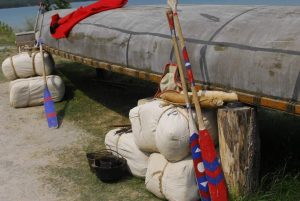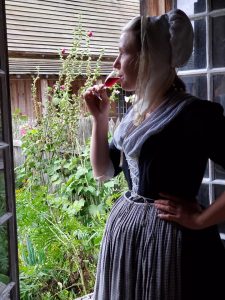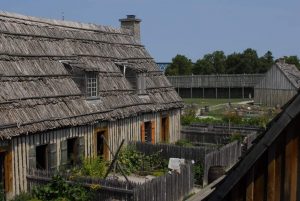 . Sally Ainse was one of many people drawn to Michilimackinac in the 18th century. During her life she worked as an interpreter, fur trader, farmer, and real estate investor. Her work in the fur trade gives us insights into how women moved through the Great Lakes during this era of business and opportunity.
. Sally Ainse was one of many people drawn to Michilimackinac in the 18th century. During her life she worked as an interpreter, fur trader, farmer, and real estate investor. Her work in the fur trade gives us insights into how women moved through the Great Lakes during this era of business and opportunity.
Ainse was born in the 1720s along the Susquehanna River to a family belonging to the Oneida Nation. In her early childhood, she was almost certainly exposed to the fur trade business. Nearly all Indigenous communities worked with traders from England, France, or Canada to purchase supplies in exchange for beaver, otter, muskrat, and any number of other furs. She grew up speaking her native language while also likely learning the European languages spoken around her.
By the age of about 18, Ainse married a fur trader named Andrew Montour. He and Ainse did not remain lifelong partners. When they separated he received custody of their older children, while she was able to keep the youngest. To support herself and her baby, she worked at a variety of jobs. As an official Indian Interpreter, Sally was able to use her highly valuable language skills to assist government officials in negotiations with various Indigenous nations. At the same time, she also bought and sold merchandise to make money in the fur trade business.

To tap into more lucrative markets, Ainse moved from the New York region further west to Niagara, Detroit, and then, in the mid-1760s, to Michilimackinac. By that time, the area was under British military control, although the trade was still being largely run by French-Canadians and Anishinaabek people. Most people at the straits were transient, which created a very diverse population, and Ainse’s own history growing up elsewhere would not have been in any way remarkable at Michilimackinac. She rented or purchased a unit in a rowhouse and clearly had the means to support herself.
Her activities at Michilimackinac were likely typical of other fur traders. While she did not leave records herself, her name does appear in a few documents related to the Michilimackinac community. In April 1774, John Askin wrote about her in his journal when she left Michilimackinac for the Grand Traverse area to meet with the Odawa living there. This meeting was likely a trading event, although Askin did not specify the exact purpose of the trip. In any case, she was not gone long and came back just a few short days later, seemingly successful in whatever she had traveled there to do.
In another instance, a British soldier named William Maxwell wrote about his interactions with Sally. Maxwell served in the British Army during some of the most well-known campaigns of the Seven Years’ War. After the war ended, he served in the western Great Lakes as commissary, and that is when he and Ainse met at Michilimackinac. In a letter between Maxwell and one of his acquaintances he described a proposal he made to Ainse:
till I was better Convinced of her Sincerity, I was willing to a small settlement for a year, and in that Time if her Temper would please me I would have pleased her if I could, but she would not trust me with her so she walked off and I did not hinder her, for she had tried me heartily, (I mean with her Tongue and Hands both) I believe on the Whole Socrates need no more be quoted for his patience with his Wife where my Storey is known.

The length of Sally and William’s relationship is unknown. Maxwell left Michilimackinac in 1772 and by 1775 Ainse had left Michilimackinac to live at Detroit. By 1779 she owned at least two houses near the city as well as livestock and enslaved people. She traded in a variety of items including fur, rum, and cider, perhaps from her own orchards. She continued to do business with John Askin, who similarly had relocated to the area from Mackinac. Ainse was well-known by Major Arent DePeyster and in 1780 when the commanding officer made a list of assets at Detroit, he included two bateau loads of merchandise as belonging to her.
Much of Ainse’s later life was spent petitioning the government. Shortly after moving to Detroit, Ainse began purchasing land on what would become the Canadian side of the Detroit River. Eventually, Sally’s ownership of many of these properties came into question, and she fought a long battle to keep them. In the end she lost most of her property after the government of Upper Canada (present-day Ontario) refused to acknowledge her ownership of the land.
Sally Ainse died in 1823 after a long life of consistently being involved in the fur trade. Her diverse work as a fur trader, interpreter, diplomat, farmer, and real estate owner was typical for the time and gives us a better understanding into how women successfully worked in the Great Lakes fur trade. Visit our website for more information or to visit the recreated fort at Colonial Michilimackinac that Ainse, Maxwell and many others called home.









